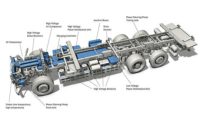Nearly everyone has heard of phrases such as "barrel of monkeys," "barrel jumping" and "barrel roll." But, few people today have actually seen a wood barrel. That wasn't the case 100 years ago.
Everything from soup to nuts was transported in wood barrels. Indeed, sugar, flour, oil, gunpowder, nails, screws, candy, cereal, fruit, vegetables, fish and countless other items, including all sorts of beverages, were shipped by the barrel full. Early household appliances, such as butter churns and hand-operated washing machines, were also made from wood barrels.
Millions of barrels and thousands of coopers were required to meet that demand. Some heavy users of barrels, such as breweries and sugar mills, operated their own cooperages. For instance, in 1889, the Bass Brewery (Burton-on-Trent, England) employed 400 coopers who could produce 2,000 barrels a week. The cooperage occupied more than 25 acres of land, including space where wood was stored and weathered.
An article in the January 1875 issue of The Manufacturer and Builder, a leading 19th century trade magazine, boasted that "the consumption of barrels in the United States exceeds that of any other country in the world. Millions upon millions are yearly manufactured and find their way, with the produce they contain, to the markets and the consumers, while all old barrels at least end their existence by being used as fuel, many of them having [previously performed] the degrading function of ash barrels."
Barrel-making was a highly skilled trade. In fact, many people considered it an art. Coopering was a skill acquired through years of back-breaking labor. Its secrets were passed down from generation to generation of fathers and sons for hundreds of years. Apprenticeships were highly coveted and lasted more than 4 years. And, to protect their livelihood, coopers organized some of the earliest and most powerful labor unions in the world. Today, only a handful of people in the world still practice this ancient trade.
Coopers assembled a wide variety of casks that ranged in size from 4 gallons to more than 100 gallons. The most common product they made was a barrel, which is a cask that holds 36 gallons. Other popular sizes included a kilderkin (18 gallons), a hogshead (54 gallons) and a puncheon (72 gallons).
A wood barrel may look simple, but it is comprised of multiple components that must fit together precisely to provide a tight seal. Early barrels were assembled from white oak slats called "staves" and hickory hoops. However, the hickory was eventually replaced by iron hoops.
According to John Seymour, author of The Forgotten Arts & Crafts (Dorling Kindersley Publishing Inc.), "the secret of a barrel's tightness is its shape. It allows iron binding hoops of fixed sizes to be driven toward the widest part, squeezing the staves together-impossible with a cylindrical shape, for example.
"If you examine a barrel stave you will see why a barrel is a very difficult thing to make," adds Seymour. "The stave is hollowed out on the concave side, rounded somewhat on the convex side, tapered at each end and, finally, its two long edges are cut on a chamfer. If you consider the geometry of a barrel, it is obvious that all the staves in it must be exactly the right shape in order that, when the hoops are driven on, all the staves fit their neighbors exactly. If one stave is out of shape by the slightest degree the barrel will leak."
Most barrels are held together with several different hoops. Every barrel contains a chime hoop on both ends. The chime hoops are usually the widest and strongest, because they take more wear and tear. Booge hoops are placed one-third of the way from the top and bottom of a barrel. Large barrels typically contain a pitch hoop in the center.
After aging, staves are formed into the correct shape to match the size of barrel needed. During a process called "dressing," the staves are cut to an equal length, tapered at each end and beveled. Then, the staves are planed on the outside and slightly hollowed on the inside.
The last and most important process in the dressing of staves is called jointing. "Jointing is one of the most skillful of all jobs in coopering," claims Kenneth Kilby, author of The Cooper and His Trade (Linden Publishing Inc.). "The cooper is required to get just the right amount of shot, or angle, on the edge of the stave corresponding to the radius of the cask on the end and in the belly. Jointing determines the amount of belly the cask will have. It takes a vast amount of practice to acquire the accuracy necessary to make leak-proof joints and to be able to hold the stave to your eye and gauge the height of the cask."
Coopers assemble the staves inside a metal hoop that serves as a jig. This critical process is called "raising up." With all the necessary staves raised up, the hoop is hammered tight and other hoops are added.
Then, the barrel is carefully heated over a wood fire for approximately 30 minutes to make the staves flexible. Coopers use a winch to gradually arch the staves and tighten them to obtain the shape of the barrel body. Next, a croze, or groove, is cut into the ends of the staves to accommodate the barrel heads, which are made by doweling several planks of wood together and cutting a circle.
Riveting is a crucial part of the barrel assembly process. Cold rivets are forced through the mild steel of the hoop. "The cooper must make sure that his rivet is central, and if he is careful and hits it with sufficient force, the rivet will make its own hole through the hoop," says Kilby. "But, if it is not hit fair and square, it will shoot out like a bullet. Many a window was shattered by a stray rivet."
Glue was introduced into the coopering process in 1866. It was poured into a barrel which was then rotated, coating the interior with a continuous skin to make it tight.
Coopers used a wide variety of hand tools with colorful names, such as an adze, a bick iron, a bung-hole bushing tackle, a chince, a chiv, a croze, a knocker-up and a round shave. They were often made individually to a cooper's unique requirements. Many of the tools featured curved blades and short handles designed for accurate one-handed use, because the cooper's other hand was used to support the barrel.
The advent of automated production equipment transformed the barrel-making industry. In 1811, the first patent for a coopering machine was taken out in England. The machine was for cutting barrel heads. Other devices quickly followed, which allowed manufacturers to mass-produce prefabricated components.
In the tradition-minded world of coopers, most barrel assembly continued to be performed manually. However, the discovery of oil in the mid-19th century created an unprecedented demand for barrels and new manufacturing processes were adopted.
By the 1880s, most large cooperages were using semiautomated equipment. In February 1885, The Manufacturer and Builder examined some of "the long list of highly ingenious machines that have been devised for performing rapidly and efficiently the numerous details of the cooper's handicraft. So many special machines have been devised for this branch of trade, that there is scarcely any part of cooper-work that cannot now be performed by machine-work."
Two of the leading manufacturers of barrel-making machinery in the United States were John Greenwood & Co. (Rochester, NY) and E. & B. Holmes (Buffalo, NY). They offered a wide variety of equipment, such as stave-cutting machines, stave-bolt equalizers, stave-jointers, barrel-head turning machines and barrel-head dressing machines. The cast-iron machines were produced in various sizes and were powered by overhead line shafts and belts attached to steam engines.
According to Kilby, the jointing machine was the most complicated of all the coopering machines. "The staves were carried along a chain between two inclined and revolving knives," he explains. "A template, differing according to the width of the stave and the height needed for each type of cask, caused the stave to fall into the widest position between the revolving knives at the center of the stave. The angle of the knives was adjusted to the radius of the head and was reduced with wider staves. The rate of feed of this machine was eight per minute."
Coopers were early users of flexible assembly equipment. "A considerable number of machines were necessary for the many different processes involved," says Kilby. "The number of sizes of casks made it necessary to have adjustable machines."
Despite productivity advantages, "coopers were resentful of these developments and looked upon machinery as a serious rival," says Kilby. As a result, it was not uncommon to find cooperages using labor-intensive assembly processes up until World War II.
Today, wood barrels are still made by hand at some distilleries that rely on wood to age their products. But, most mass-produced barrels are made from plastic, steel, aluminum, fiberglass or paper composites in a one-piece mold or casting.





